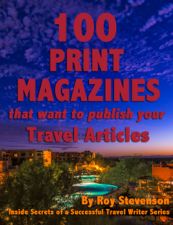Writers Guidelines
Tips for Selling Your Travel Stories
By Roy Stevenson

Freelance travel writers are constantly submitting query letters to editors you’ve never met. What if there was a place to go to find out exactly what the editors want?
As it turns out, there is.
Writers guidelines give a set of rules that have been painstakingly compiled by magazine publishers or editors. These guidelines lay out in detail exactly what the editor is looking for. They explain what types of articles the editor expects for his magazine and how he or she would like them presented.
Writer’s guidelines save the editor from suffering from off-target queries that waste time and that drive them that little bit closer to editor’s purgatory. They’re meant to make editor’s lives easier, while reading them is supposed to improve the freelancer’s chances of being published.
Traditionally, it’s been standard practice for freelance writers to review the guidelines for every magazine before sending out queries. This was back in the day when writers were expected to create tailor-made query letters for every magazine they pitched.
And therein lies the problem with writers guidelines. Travel writers spend a lot of time reading these guidelines.
I know several writers who spend such an inordinate amount of time reviewing the guidelines that they never get around to sending out their query letters. One writer told me that she spent three days reading the guidelines and still hadn’t sent out any queries.
I also know travel writers who’ve been so obsessed with the minutiae of writers guidelines that they’ve been deterred from pitching stories to the magazine. It stopped them from pitching completely.
Is it necessary to read the writer's guidelines before you send a query to an editor?
Studying writer’s guidelines in-depth is a time consuming process and unnecessary before you pitch a story.
The days of putting all your query eggs in one magazine basket are long gone. In this age of mass distribution query letters, you simply don’t have to do this anymore.
I can count on one hand the tailor-made queries I’ve sent out in 12 years of travel writing, yet, I’ve sold more than 1,000 articles to 200+ publications.
How can I ignore this long-established rule and still be published prolifically? The prime reason is because I send out dozens of simultaneous submissions without customizing my query letters.
Yes, I know this is heresy! But, if I had used the old school custom-built query letter approach I doubt very much that I would have even sold 100 articles in ten years. The old approach just doesn’t work anymore.
Only elite writers can expect to send made-to-order queries out to one or two magazines, and meet consistent success. Novice writers need to follow a different path for success.
What is relevant today with writers guidelines before you pitch a story?
I don’t think you need to scrutinize guidelines too closely before you pitch your travel story idea to a magazine. Before you write your query letter, there are two things you should look for in the writers guidelines. They are . . .
1. Who to send your query to, including name & contact details
2. Does the publication pay writers for articles?
Weeding out the non-paying magazines will save you hours of time, and heartbreak. Imagine sending your pitch to a magazine and then receiving an email back from the editor saying, “We’re interested in your story but we don’t pay”.
If your read through the guidelines and payment isn't mentioned - be wary! Guidelines that fail to mention the pay scale usually indicates they do not pay their writers.
Rather than spending huge tracts of valuable time ingesting the guidelines, you’re better off spending your time choosing red hot story topics, researching your destinations for unique and interesting facts and details, and preparing your magazine distribution lists to pitch.
When should you study magazine’s writer’s guidelines in depth?
When an editor responds to your query with, “We’ll buy your story”, the first thing you should do is go to the magazine’s guidelines.
The guidelines will provide specific details about how you’re going to write your article. I’ve listed twelve of the most common writers guidelines details at the end of this article.
Help! I can't find any writers guidelines
What if you can't find guidelines for a particular publication? It happens. In fact, you’ll encounter many magazines that don’t provide writer’s guidelines. My experience has been that there are far more magazines without guidelines than with them!
What do you do if a magazine doesn’t provide guidelines?
You’ll have to fly blind. Keep your queries middle-of-the-road and hope for the best. I’ve had stories published in plenty of magazines that do not provide writer’s guidelines. I’ll look through a past issue of the magazine. Then I’ll write my query letter in a similar tone to what I saw in the magazine.
Where can you find writer's guidelines?
You’ll often find writers guidelines posted on the magazine’s website. Look under headings such as “Write for Us”, “Writer’s Guidelines”, “Contributors Guidelines”, “Submissions Guidelines”, “Tips for Writers”, even “Contact Us”, or something similar.
Occasionally you’ll find a magazine that insists you write to them and request their writer’s guidelines. This doesn't happen often, but sometimes you'll encounter one of these dinosaurs.
Here are some sources you can use if you can't find the guidelines online, and for people who like these references at their fingertips. I have a stack of resources at my desk to supplement what I'm able to find online:
The American Directory of Writer’s Guidelines - lists writers guidelines for 1700 magazines. Here's an affiliate link to this reference on amazon.com:
There’s also a treasure trove of writer’s guidelines to be found in Writer’s Market - (3,500 listings.)
I recommend you spend a little more for the Deluxe Edition for its online section, Writersmarket.com. The online section has over 6,000 listings, and is updated daily.
I don’t believe you need to purchase a Writer’s Market annually. I’d say about every two or three years will keep you current. But do not throw your dated copies out when you get an updated copy. There will still be magazines listed in your old copies that no longer post in the new ones. Here's an affiliate link to this reference on amazon.com:
Writer's Market Deluxe Edition 2016: The Most Trusted Guide to Getting PublishedIf you’re writing for U.K. publications, here are two U.K. references available on amazon.com (affiliate link):
Writers’ & Artists’ Yearbook,
Writer’s Handbook
NOTE: None of the publications listed above have every listing you might be looking for. You still may have to go through the process of locating the writers guidelines elsewhere. In fact, I use three sources for all of my sales leads, including the publications mentioned here.
12 Useful Details in Writers Guidelines
Writers guidelines are usually only a page or two long. They cover a number of important details such as:
1. Who you’ll send your query to - editor’s name & contact details
2. How much they pay for articles and columns. Magazines pay in mysterious ways. It could be per word, by the page, by a flat rate for each article, or by other strange and convoluted formulas. It's their publication. They make the rules - be sure to read them.
3. When they pay for published articles. Some magazines pay upon receipt of story. Others pay on publication or 30-60 days after publication. This affects your cash flow so be sure to read it carefully so you know when you can expect to be paid.
4. The preferred article length for their publication.
5. How to submit queries and articles. Most magazines these days accept queries via email, but there are still some that want your query sent through snail mail.
6. The theme for each issue or topics they’re interested in publishing. Sometimes there is a very distinct schedule with deadlines for queries on certain topics. The guidelines will lay these out formally.
7. The style and pace they prefer for their articles. They will spell out first person, third person, edgy, short, upbeat, fast-paced, detailed, humorous, use of quotes, and so on. It helps to read a few articles in the magazine if you're unsure about their definitions.
8. The format of your manuscript. Sometimes you'll see requirements like font type, size, double-spaced, whether they require reference lists, and similar types of requirements.
9. The lead time for articles. For example, if you are submitting a winter themed story, the guidelines will tell you when you need to submit your article.
10. Whether they require photos to accompany your travel story. Some publications won't accept your article without high resolution photos.
11. Whether or not they pay for photographs. Editors might require photos for travel stories, but some don't pay for the photos, while others do. Other editors prefer to supply their own photos.
12. What rights the magazine assumes. This is important if you think you might want to resell your article later.
Here’s a quick summary for managing the writer’s guidelines:
1. Scan the writer’s guidelines before you query for items contact details and payment information (items #1, #2, #10 & #11 above).
2. After the editor buys your story, read the rest of the guidelines for further guidance while you’re writing the article.
Focus on what's important before pitching your travel stories. Don't get stuck on details too early in the process.
If you want to get published in print media, 100 Print Magazines that Want to Publish Your Travel Stories gives you a ready-made a list of print magazines with contact details, writers guidelines, and much more.
Related articles that will interest you:
Finding Travel Magazine Sales Leads on Vendor Websites
Using Simultaneous Submissions to Sell More Stories
Getting Published: The Many Ways to Sell Your Travel Articles

Roy Stevenson is a professional travel writer and the author of www.PitchTravelWrite.com. Over the past ten years, he’s had more than 1000 articles published in 200 magazines, trade and specialty journals, in-flights, on-boards, blogs and websites and has traveled on assignment around the U.S. and to dozens of international destinations.
IF YOU ENJOYED THIS POST, GET UPDATES. IT'S FREE.














